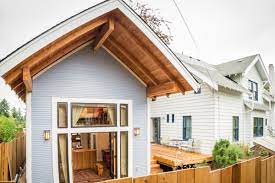by Ron Witcher – Certified Residential Real Property Appraiser and Instructor
“I just finished the room above the garage. It is an ADU now, right? “Or “How much extra value does my house get now that it is an ADU”? I get these types of questions a lot and the most accurate answer is…it depends.
The real estate landscape is evolving, and with it, the concept of housing is undergoing a transformation. One term that has gained prominence in recent years is “Accessory Dwelling Unit” (ADU). For appraisers and real estate agents, understanding the intricacies of ADUs is crucial in accurately assessing property values and providing informed guidance to clients. In this article, we will explain that they are, their benefits, and the key considerations for real estate professionals.
Defining Accessory Dwelling Units (ADUs):
An Accessory Dwelling Unit, often referred to as a carriage house, in-law suite, or garage apartment, is a self-contained residential unit that exists on the same property as a primary residence. These units can take various forms, including detached structures, converted garages, or basement apartments. The primary purpose of ADUs is to provide additional living space while maintaining a degree of independence from the main residence.
To be considered and ADU, mentioned in the Fannie Mae Selling Guide, it must:
- Be subordinate in size to the primary dwelling.
- Have the following separate features: Ingress/egress
- Kitchen
- Sleeping area
- Bathing area
- Bathroom facilities
Benefits of ADUs:
1.Potential Increased Property Value: One of the significant advantages of having an ADU is the potential increase in property value. Depending on the market, values can vary greatly.
2. Rental Income Potential: ADUs present an opportunity for homeowners to generate rental income, offering a practical solution for addressing housing shortages or taking advantage of short-term rental opportunities. Professionals should evaluate the rental market in the area when determining the impact of an ADU on property value.
3. Multigenerational Living: With changing family dynamics, multigenerational living arrangements are becoming more common. ADUs provide a way for families to stay connected while maintaining some level of autonomy.
Key Considerations:
1. Local Zoning Regulations: RE Professionals must familiarize themselves with local zoning regulations governing ADUs, as these can vary widely. Understanding the permissible size, location, and usage of ADUs is crucial for an accurate property valuation.
2. Quality of Construction: Assessing the quality of construction for ADUs is paramount. Of importance are the materials used, the level of finish, and whether the unit complies with building codes. A well-built ADU is likely to have a more positive impact on property value.
3. Market Demand: The demand for ADUs can vary by market. Professionals and homeowners alike should stay informed about local market trends and preferences to gauge the impact of ADUs on property values in a specific area.
Conclusion:
Depending on the market, Accessory Dwelling Units can be a significant factor in property valuation. Appraisers and real estate agents must adapt to this shift, understanding the benefits and considerations associated with ADUs to provide accurate and insightful assessments. As the housing market continues to evolve, staying knowledgeable about trends like ADUs is essential for professionals dedicated to delivering informed and valuable services to their clients.

